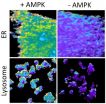(Press-News.org) By analyzing the activity of "GPS" neurons in mice, researchers at the Stanford University School of Medicine have discovered that the mental maps created by these cells accumulate errors, which are corrected when the animal encounters a wall.
The findings support the theory that these cells, called grid cells, use an animal's perceived speed and direction to help it navigate familiar places.
Thus, as you stumble through your pitch-black kitchen in the middle of the night for a glass of water, your body knows how many steps to take and when to turn to get to the sink. Scientists believe grid cells are responsible for constructing the internal, GPS-like map that keeps you from colliding with the refrigerator.
But grid cells can make small errors, the Stanford researchers assert, taking you to the dishwasher instead of the sink, at which point other nearby neurons, called border cells, assist in reorienting the grid cells to correctly map your current position.
How the brain integrates this sensory and motion data is one of the big open questions of spatial navigation. A paper that helps to answer that question will be published April 16 in Neuron. Lisa Giocomo, PhD, assistant professor of neurobiology at Stanford, is the senior author; the lead author is graduate student Kiah Hardcastle. This work was done in close collaboration with the theory lab of Surya Ganguli, PhD, assistant professor of applied physics at Stanford, who is the other co-author on the study.
Learning from Nobel laureates
A decade ago, grid cells were identified in the entorhinal cortex of the brain by Norwegian scientists May-Britt Moser, PhD, and Edvard Moser, PhD, who were among the winners of last year's Nobel Prize for the discovery of the neurons involved in self-location and navigation. They found individual cells that fired consistently when a mouse wandered past certain places in both light and dark enclosures. At each of these places, a unique set of grid cells activated, presumably signaling to cells in the hippocampus the mouse's location.
"You can think of them as a neurological longitude and latitude system," said Giocomo, who did postdoctoral work with the Mosers at the Kavli Institute of Systems Neuroscience/Centre for Neural Computation at the Norwegian University of Science and Technology.
It was there that she collected data from 11 mice, each outfitted with a microdrive. The device, surgically implanted in the mice's brains, contained numerous microelectrodes, each with the ability to record from several neurons, including grid cells, so researchers could monitor the firing of several cells simultaneously. During the 40- to 50-minute session that each mouse spent exploring a dark, 1-square-meter space, a particular set of grid cells would activate in its brain when it arrived at certain place within the enclosure.
But when Hardcastle, a graduate student in Giocomo's lab, analyzed specific paths where the mouse spent a long time far away from the border, she found that the grid cells began firing when the animal was not quite in the place where the cells usually fired. Over time, the cells would lose accuracy and begin to fire when the mouse was at an increasing distance from that place. But encountering a wall corrected this discrepancy. Giocomo suspects border cells are responsible for this correction.
Rapid rate of errors
The speed at which the grid cells acquired errors surprised her. "Within two minutes, the maps started to drift," she said. "We thought it would take 30 to 40 minutes."
However, a particular set of grid cells wouldn't fire when the mouse was a long way from the place where those cells were supposed to fire. This supports the theory that grid cells use speed and direction to calculate the animal's location; errors could creep in if the mouse misestimated its speed or turned too much, or not enough. These small mistakes would accumulate the more it traveled, explained Hardcastle, and lead to larger errors.
The research "represents an important step forward in understanding how spatial cues from the outside world influence spatial representations inside the brain," said neuroscientist Ila Fiete, PhD, of the University of Texas at Austin, who was not involved in the study.
Giocomo and her students have gathered an even larger data set from mouse studies in her Stanford lab and are planning to study grid cells in rats, as well. Giocomo is interested in investigating how more complex visual information, as well as touch and smell, is used to correct grid cells, and for that, they need to be able to sample more neurons. Rats also have the advantage of being more curious and less inclined to stick to the walls of the enclosure, Hardcastle said.
INFORMATION:
The study was supported by grants from Burroughs-Wellcome, the James S McDonell Foundation, the Simon's Foundation, the Alfred P. Sloan Foundation and Stanford's Bio-X Interdisciplinary Initiatives Program.
Information about Stanford's Department of Neurobiology, which also supported the work, is available at http://neurobiology.stanford.edu.
The Stanford University School of Medicine consistently ranks among the nation's top medical schools, integrating research, medical education, patient care and community service. For more news about the school, please visit http://med.stanford.edu/school.html. The medical school is part of Stanford Medicine, which includes Stanford Health Care and Lucile Packard Children'€™s Hospital Stanford. For information about all three, please visit http://med.stanford.edu.
Men give more money through fundraising websites after seeing that other men have donated large amounts and when the fundraiser is an attractive woman, according to new UCL and University of Bristol research.
The scientists say this response by men is unlikely to be conscious and could have an evolutionary function as theories predict that generous actions can honestly signal hidden qualities, such as wealth or desirable personality attributes, to potential partners.
Co-author Dr Nichola Raihani from UCL (Life Sciences), said: "We looked at why people behave generously ...
A nerve neglected in today's era of molecular and genetic analysis has yielded a surprising secret. A handful of neurons control breathing in a fine-tuned but powerful way, scientists have discovered in mice. Among these sensory neurons, two types are dedicated to two specific respiratory functions.
The findings, published in Cell, suggest new ways of considering clinical conditions related to the vagus nerve.
The team, led by Stephen Liberles, Harvard Medical School associate professor of cell biology, has effectively deconstructed the vagus nerve, a key connection ...
The enzyme AMPK initiates a dizzying array of cellular activities, from breaking down worn-out cellular parts to turning on energy production. How does a single protein, activated by a single switch, fulfill so many different tasks without getting them mixed up? To get at such a complex question, cell biologists at Johns Hopkins designed several molecular tools that allowed them to watch, measure and manipulate the activity of the enzyme AMPK in individual compartments within the cell. The new tools have confirmed that at least some of AMPK's ability to multitask comes ...
Angiogenesis inhibitors--a widely used class of cancer drugs designed to shrink tumors by preventing them from forming new blood vessels--often work in the short term, but usually become ineffective within months. Now, a team led by UC San Francisco scientists has discovered a possible reason, one that could lead to a way to address the problem and prevent cancer relapse.
Working with laboratory models of pancreatic and breast cancer, the scientists found that myeloid cells, which originate in bone marrow and are part of the body's first-line of defense--the so-called ...
How does climate change affect the occurrence and distribution of species? This is a key question in the climate debate, and one that is hard to answer without information about natural variation in species abundance. Now researchers from Uppsala University can, for the first time, give us a detailed picture of natural variation through a major study published today in the leading scientific journal Current Biology.
The impact of climate change on species occurrence and distribution is a central issue in the climate debate, since human influence on the climate risks posing ...
The nutrients excreted by fish in their "pee" may be critical to the health of coastal ecosystems. But knowing whether generalizations can be made about how to predict these nutrient levels in various ecosystems has vexed researchers - until now.
In a paper published in Proceedings of the National Academy of Sciences, North Carolina State University associate professor Craig Layman and colleagues show that ecologists can better predict the rates of how these chemical nutrients are transferred by fish if they know the various fish species living in an ecosystem, along ...
An international team of scientists, led by researchers at University of California, San Diego School of Medicine, have found genetic overlap between Alzheimer's disease (AD) and two significant cardiovascular disease risk factors: high levels of inflammatory C-reactive protein (CRP) and plasma lipids or fats. The findings, based upon genome-wide association studies involving hundreds of thousands of individuals, suggest the two cardiovascular phenotypes play a role in AD risk - and perhaps offer a new avenue for potentially delaying disease progression.
The findings ...
A potentially game-changing breakthrough in artificial photosynthesis has been achieved with the development of a system that can capture carbon dioxide emissions before they are vented into the atmosphere and then, powered by solar energy, convert that carbon dioxide into valuable chemical products, including biodegradable plastics, pharmaceutical drugs and even liquid fuels.
Scientists with the U.S. Department of Energy (DOE)'s Lawrence Berkeley National Laboratory (Berkeley Lab) and the University of California (UC) Berkeley have created a hybrid system of semiconducting ...
CORVALLIS, Ore. - A national survey suggests that slightly more than half of the older adults in the United States are now taking a daily dose of aspirin, even though its use is not recommended by the Food and Drug Administration for most people who have not yet had a heart attack or stroke.
The analysis was published today in the American Journal of Preventive Medicine. It observed that aspirin use is continuing to surge, especially among adults who are using it for "primary prevention," meaning in order to prevent an initial cardiovascular event, and in some cases to ...
The psychological impact and private agony of infertility must be carefully considered by healthcare professionals, suggests a new review, published today (Friday 10 April) in The Obstetrician & Gynaecologist (TOG). The review identifies infertility as a complex state and life crisis and sets out the dangers of neglecting the emotional impact of involuntary childlessness and viewing it solely in biological or medical terms.1
The article provides an introduction to infertility counselling in the UK, within the context of fertility treatment. This includes an explanation ...


